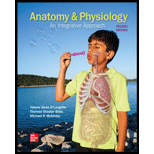
ANATOMY+PHYSIOLOGY-CONNECT ACCESS
4th Edition
ISBN: 9781264265398
Author: McKinley
Publisher: MCG
expand_more
expand_more
format_list_bulleted
Concept explainers
Question
Chapter 21, Problem 20DYKB
Summary Introduction
To explain:
How the lymphatic system supports both cardiovascular and immune system’s functions.
Concept introduction:
The lymphatic system is a part of the circulatory system and immune system that haveinterconnected lymphatic vessels which contain a clear fluid called lymph. Lymphatic system comprises lymphatic capillaries, vessels, ducts and trunks. Lymphatic system is also comprised of lymphatic tissues or organs like, tonsils, lymph nodes and nodules, spleen and MALT.
Expert Solution & Answer
Want to see the full answer?
Check out a sample textbook solution
Students have asked these similar questions
Please draw in the missing answer, thank you
Please fill in all blank questions, Thank you
please fill in missing parts , thank you
Chapter 21 Solutions
ANATOMY+PHYSIOLOGY-CONNECT ACCESS
Ch. 21.1 - What substances typically are absorbed from the...Ch. 21.1 - Prob. 2WDYLCh. 21.1 - Prob. 3WDYLCh. 21.1 - Which major body regions drain lymph to the right...Ch. 21.2 - How are primary lymphatic structures and secondary...Ch. 21.3 - Why is red bone marrow considered a primary...Ch. 21.3 - Prob. 7WDYLCh. 21.4 - Prob. 8WDYLCh. 21.4 - What are the general functions of the spleen?...Ch. 21.4 - Prob. 10WDYL
Ch. 21.4 - Prob. 11WDYLCh. 21.4 - What is the function of MALT in the mucosal...Ch. 21 - Prob. 1DYKBCh. 21 - _____ 2. Lymph is drained into the thoracic duct...Ch. 21 - _____ 3. The spleen is a secondary lymphatic...Ch. 21 - Prob. 4DYKBCh. 21 - _____ 5. Which type of lymph vessel consists...Ch. 21 - _____ 6. Which statement is accurate about lymph...Ch. 21 - In an early Streptococcus infection of the throat,...Ch. 21 - _____ 8. The lymphatic trunk that drains lymph...Ch. 21 - _____ 9. Aged erythrocytes are removed from...Ch. 21 - _____ 10. Interstitial fluid that is absorbed into...Ch. 21 - Prob. 11DYKBCh. 21 - Prob. 12DYKBCh. 21 - Prob. 13DYKBCh. 21 - Which body regions have their lymph drained to the...Ch. 21 - Describe how the thymuss anatomy changes as we...Ch. 21 - Prob. 16DYKBCh. 21 - Compare and contrast the red and white pulp of the...Ch. 21 - Describe the specific locations of the tonsils.Ch. 21 - Describe the location and function of diffuse...Ch. 21 - Prob. 20DYKBCh. 21 - Prob. 1CALCh. 21 - A child born without his thymus would not have...Ch. 21 - Prob. 3CALCh. 21 - Prob. 4CALCh. 21 - Prob. 5CALCh. 21 - Prob. 1CSLCh. 21 - Jordan has an enlarged lymph node along the side...Ch. 21 - Prob. 3CSL
Knowledge Booster
Learn more about
Need a deep-dive on the concept behind this application? Look no further. Learn more about this topic, biology and related others by exploring similar questions and additional content below.Similar questions
- please draw in the answers, thank youarrow_forwarda. On this first grid, assume that the DNA and RNA templates are read left to right. DNA DNA mRNA codon tRNA anticodon polypeptide _strand strand C с A T G A U G C A TRP b. Now do this AGAIN assuming that the DNA and RNA templates are read right to left. DNA DNA strand strand C mRNA codon tRNA anticodon polypeptide 0 A T G A U G с A TRParrow_forwardplease answer all question below with the following answer choice, thank you!arrow_forward
- please draw in the answeres, thank youarrow_forwardA) What is being shown here?B) What is indicated by the RED arrow?C) What is indicated by the BLUE arrow?arrow_forwardPlease identify the curve shown below. What does this curve represent? Please identify A, B, C, D, and E (the orange oval). What is occurring in these regions?arrow_forward
- Please identify the test shown here. 1) What is the test? 2) What does the test indicate? How is it performed? What is CX? 3) Why might the test be performed in a clinical setting? GEN CZ CX CPZ PTZ CACarrow_forwardDetermine how much ATP would a cell produce when using fermentation of a 50 mM glucose solution?arrow_forwardDetermine how much ATP would a cell produce when using aerobic respiration of a 7 mM glucose solution?arrow_forward
- Determine how much ATP would a cell produce when using aerobic respiration to degrade one small protein molecule into 12 molecules of malic acid, how many ATP would that cell make? Malic acid is an intermediate in the Krebs cycle. Assume there is no other carbon source and no acetyl-CoA.arrow_forwardIdentify each of the major endocrine glandsarrow_forwardCome up with a few questions and answers for umbrella species, keystone species, redunant species, and aquatic keystone speciesarrow_forward
arrow_back_ios
SEE MORE QUESTIONS
arrow_forward_ios
Recommended textbooks for you
 Biology (MindTap Course List)BiologyISBN:9781337392938Author:Eldra Solomon, Charles Martin, Diana W. Martin, Linda R. BergPublisher:Cengage Learning
Biology (MindTap Course List)BiologyISBN:9781337392938Author:Eldra Solomon, Charles Martin, Diana W. Martin, Linda R. BergPublisher:Cengage Learning Human Physiology: From Cells to Systems (MindTap ...BiologyISBN:9781285866932Author:Lauralee SherwoodPublisher:Cengage Learning
Human Physiology: From Cells to Systems (MindTap ...BiologyISBN:9781285866932Author:Lauralee SherwoodPublisher:Cengage Learning




Biology (MindTap Course List)
Biology
ISBN:9781337392938
Author:Eldra Solomon, Charles Martin, Diana W. Martin, Linda R. Berg
Publisher:Cengage Learning


Human Physiology: From Cells to Systems (MindTap ...
Biology
ISBN:9781285866932
Author:Lauralee Sherwood
Publisher:Cengage Learning